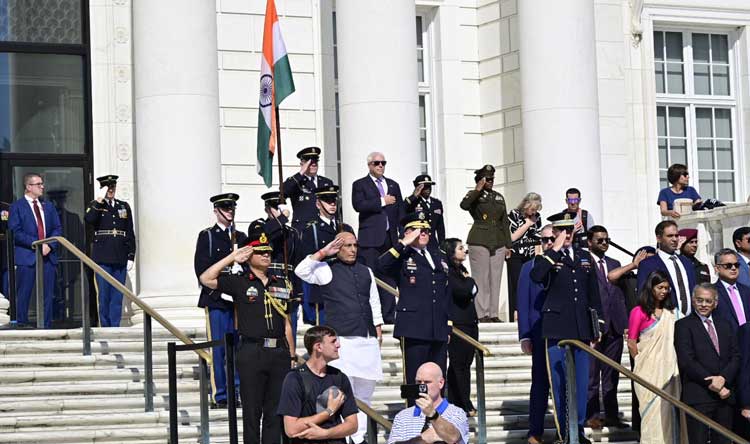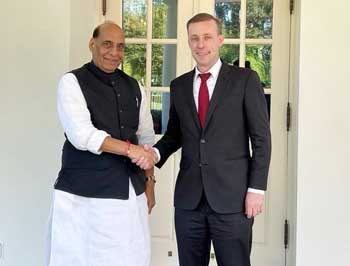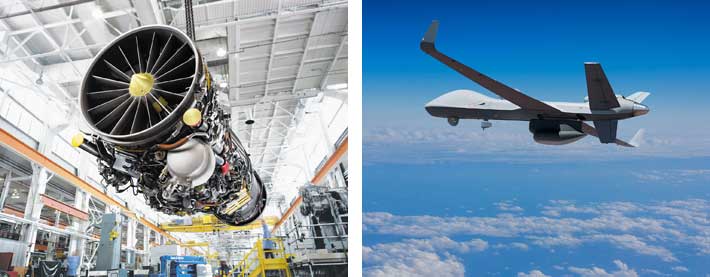INDIAN ARMED FORCES CHIEFS ON OUR RELENTLESS AND FOCUSED PUBLISHING EFFORTS

The insightful articles, inspiring narrations and analytical perspectives presented by the Editorial Team, establish an alluring connect with the reader. My compliments and best wishes to SP Guide Publications.

"Over the past 60 years, the growth of SP Guide Publications has mirrored the rising stature of Indian Navy. Its well-researched and informative magazines on Defence and Aerospace sector have served to shape an educated opinion of our military personnel, policy makers and the public alike. I wish SP's Publication team continued success, fair winds and following seas in all future endeavour!"

Since, its inception in 1964, SP Guide Publications has consistently demonstrated commitment to high-quality journalism in the aerospace and defence sectors, earning a well-deserved reputation as Asia's largest media house in this domain. I wish SP Guide Publications continued success in its pursuit of excellence.
- MoD initiates comprehensive review of Defence Acquisition Procedure 2020, pushes for defence reforms
- G7: The Swansong
- Kalinga Connect: South Asia to Polynesia
- Advanced MRSAM for India for a greater firepower
- Must Credit DRDO for Operation Sindoor, now what is next for defence R&D?
- Operation Sindoor | Day 2 DGMOs Briefing
- Operation Sindoor: Resolute yet Restrained
Defence Minister Visits USA
During the visit, Rajnath Singh invited US defence companies to collaborate with Indian partners to accelerate the “Make in India” programme, aiming for joint co-development and co-production in defence technologies
 |
The Author is Former Director General of Information Systems and A Special Forces Veteran, Indian Army |

Defence Minister Rajnath Singh departed India on August 21, 2024 for a five-day visit to the US to strengthen the US-India comprehensive strategic relationship. His visit was viewed as a prelude to the visit of Prime Minister Narendra Modi to the US in September 2024, as also to somewhat douse the heat generated in the US because of Prime Minister Modi's visit to Russia in July 2024 for the 22nd India–Russia Annual Summit.
Earlier on July 31, 2024, theDefence Acquisition Council (DAC), headed by Defence Minister Rajnath Singh, cleared the MQ-9B Predator drone deal "with amendments" and the Indian Navy's tie-up with HawkEye 360 as part of the much awaited QUAD Indo-Pacific Partnership of Maritime Domain Awareness (IPMDA).
Defence Minister Rajnath Singh's visit to the US was seen as a prelude to Prime Minister Narendra Modi's visit to the US in September 2024, aimed at strengthening the US-India strategic relationship
The amendments pertained to the percentage of indigenisation and putting a DRDO developed and manufactured anti-ship missile on the Predator.While, indigenisation percentage agreed is 30 per cent,mounting a DRDO missile on the Predator was dropped because General Atomics quoted a huge price for the DRDO missile-Predator integration.


In addition to procuring 31 Predator UAVs from the US at a cost of $3.9 billion along with missiles and guided bombs, the Modi government has cleared the Indian Navy joining the IPMDA, which was announced by QUAD nations in May 2022. The IPMDA is designed to keep QUAD nations on the same page in the Indo-Pacific and prevent any country from impeding freedom of navigation in the contested South-East Asia. The Indian Navy will follow the other QUAD nations in tying up with the HawkEye 360 commercial operator for transparency in the Indo-Pacific through satellites. The HawkEye 360 satellites pick up any radio frequency emission for a vessel that has deliberately switched off its transponders; providing covert surveillance in the Indo-Pacific.
The Defence Acquisition Council cleared the MQ-9B Predator drone deal "with amendments," including a 30 per centindigenisation requirement but dropping the integration of a DRDO missile due to high costs

Interestingly, before the departure of Defence Minister Rajnath Singh for the US, media reported that his visit will act as a booster dose for Hindustan Aeronautics Limited (HAL), with the company's stock already having risen by 146.98 percent in three months.
In the US, Defence Minister Rajnath Singh met the US National Security Advisor Jake Sullivan and shared perspectives on key strategic matters of mutual interest. After the meeting, he posted on X: "Delighted to meet the National Security Advisor of the United States @jakesullivan and share perspectives on key strategic matters of mutual interest." Defence Minister Rajnath Singh also met with his US counterpart Lloyd Austin at the Pentagon to further cement the Indo-US bilateral defencecooperation after which, he wrote on X: "Excellent meeting with my dear friend @SecDef Lloyd Austin. We reviewed the existing defence cooperation activities and discussed ways to deepen it further."

At a luncheonmeeting organised by the (US India Strategic Partnership Forum (USISPF), attended by board members and industry leaders, Defence Minister Rajnath Singh invited leading US defence companies and invited them to work with Indian partners to accelerate the "Make in India"programme towards achieving Atmanirbharta in the defence sector together Indian and US companies will co-develop and co-produce for the world. He touched on the evolution and phenomenal growth of the US-India defence relationship and how investments from American companies will play a central part in India's growth story and vision 2047. He talked of building on the defence cooperation and elevating the strategic partnership through deeper defence engagements at multiple levels.
Two agreements were signed between India and the US: the Security of Supplies Arrangement (SOSA) and a Memorandum of Agreement on Liaison Officers, enhancing mutual defence support and industrial cooperation
President and CEO of USISPF Mukesh Aghi later said that Rajnath Singh touched on the "evolution of the defence relationship and the strategic depth, where the private sector now plays an epochal role in driving deep defence synergy in new areas of critical and emerging technology, such as cyber, drones, AI, space, and quantum."
India and the US signed two agreements during Defence Minister Rajnath Singh's above visit. These agreements pertain to the Security of Supplies Arrangement (SOSA) and a Memorandum of Agreement regarding the Assignment of Liaison Officers (Los). These agreements were formally signed by Dr Vic Ramdass, Principal Deputy Assistant Secretary of Defence for Industrial Base Policy, representing the United States, and Samir Kumar Sinha, Additional Secretary and Director General (Acquisitions), representing India.


SOSA ensures that the US and India will provide each other with reciprocal priority support for goods and services essential to national defence. It is designed to ensure that both nations can swiftly secure necessary industrial resources from one another in the event of unforeseen supply chain disruptions, thereby enhancing their national security capabilities. India is the 18th SOSA partner of the US. Other SOSA partners include Australia, Canada, Denmark, Estonia, Finland, Israel, Italy, Japan, Latvia, Lithuania, the Netherlands, Norway, the Republic of Korea, Singapore, Spain, Sweden, and the UK.
A press release by the US Department of Defence (DoD) said, "Through this SOSA, the US and India agree to provide reciprocal priority support for goods and services that promote national defence. The Arrangement will enable both countries to acquire the industrial resources they need from one another to resolve unanticipated supply chain disruptions to meet national security needs."
There are concerns over delays in the transfer of technology and supply of GE engines for India's Tejas fighter jets, highlighting challenges in the US-India defence collaboration
A CNBC report on Defence Minister Rajnath Singh's visit to the US has stated that under SOSA, the US will assure India through the US Defence Priorities and Allocations System (DPAS), The Department of Defence (DoD) will determine the programme, and the Department of Commerce (DoC) will authorise the rating. Also, as part of the agreement, India's industrial base will create a government industry code, under which Indian companies would voluntarily pledge to use all reasonable means to assist US military interests "first". This last part is rather intriguing.


Finally, the US no doubt is good at paperwork and signing agreements and deals, but needs to be as sincere in execution, Case in point is the India-US deal on transfer of technology (ToT) for the GE-F414 engines, which are to power the Tejas Mk-1A and Mk-II fighter jets. It has emerged that the ToT is not 100 per cent, as was announced earlier. Moreover, India is witnessing a delay in off-the-shelf supply of GE-F404 engines, which has unduly delayed the production of the Tejas Mk-1A fighter jets. This has been covered in these columns earlier. There is urgent need for the US to fast-track delivery of GE-F414 engines to India, but whether the issue was specifically discussed during this visit of the defence minister to the US is not known.





